13-hydroxysparteine cinnamic acid derivatives with anti-tumor activities and a method of preparing the same
Liang , et al.
U.S. patent number 10,233,183 [Application Number 16/043,085] was granted by the patent office on 2019-03-19 for 13-hydroxysparteine cinnamic acid derivatives with anti-tumor activities and a method of preparing the same. This patent grant is currently assigned to SHAANXI UNIVERSITY OF SCIENCE AND TECHNOLOGY. The grantee listed for this patent is Minghui Chang, Xingke Ju, Han Li, Chengyuan Liang, Yuzhi Liu, Kaiqi Shi, Yonghong Tang, Lei Tian, Xuechuan Wang, Lili Wen. Invention is credited to Minghui Chang, Xingke Ju, Han Li, Chengyuan Liang, Yuzhi Liu, Kaiqi Shi, Yonghong Tang, Lei Tian, Xuechuan Wang, Lili Wen.
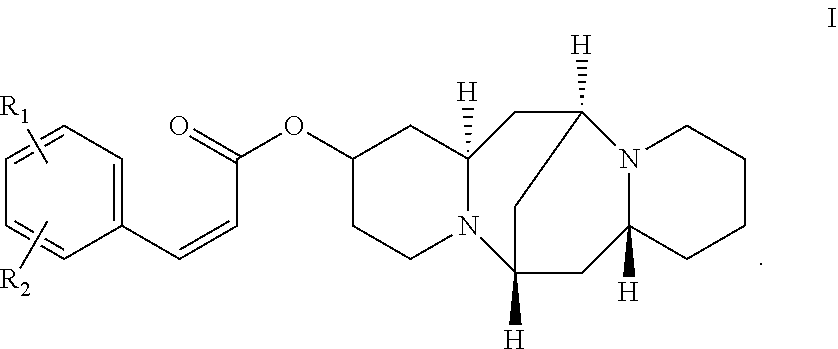
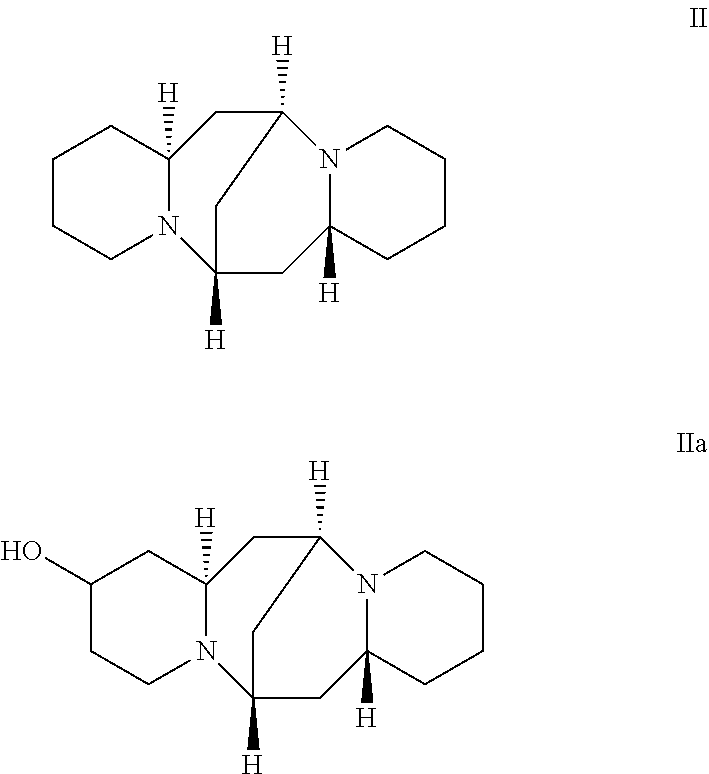
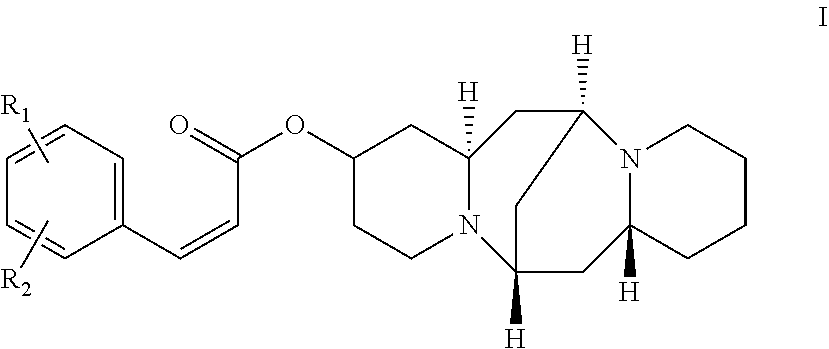
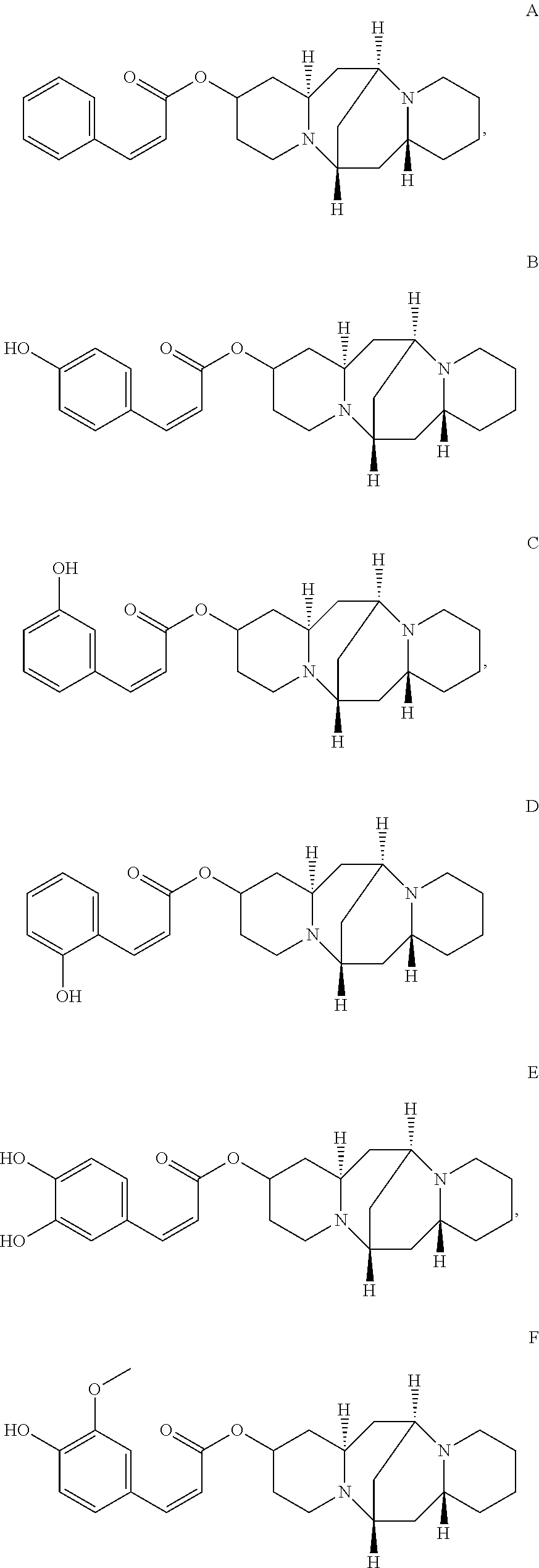
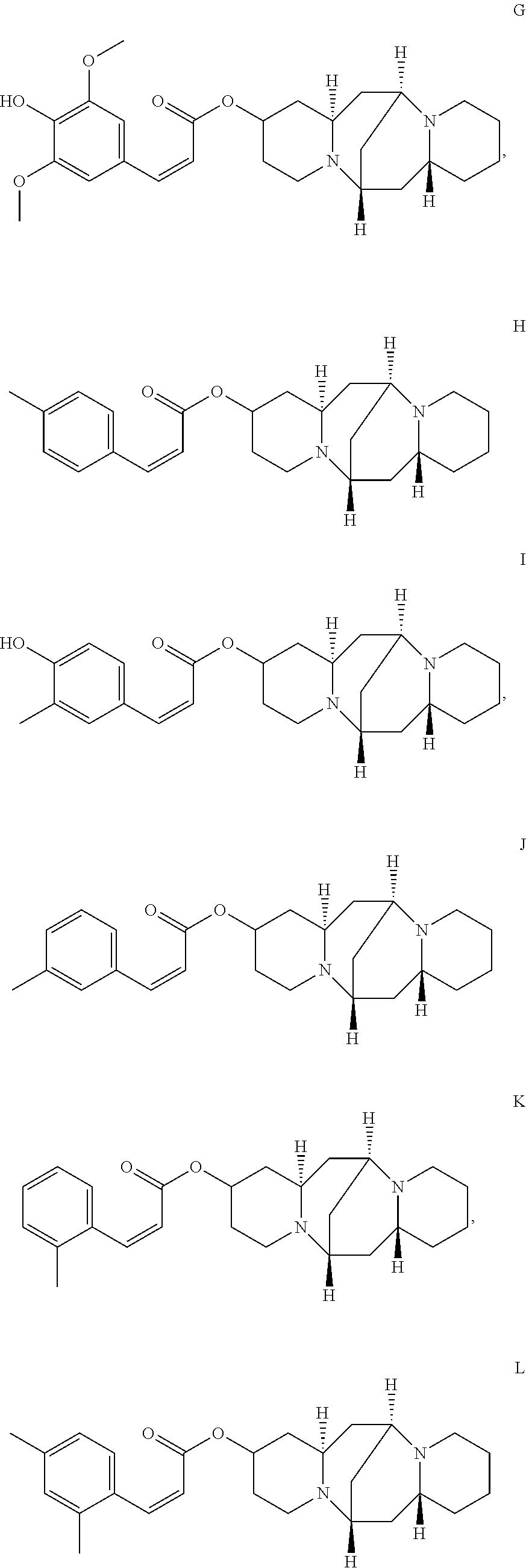
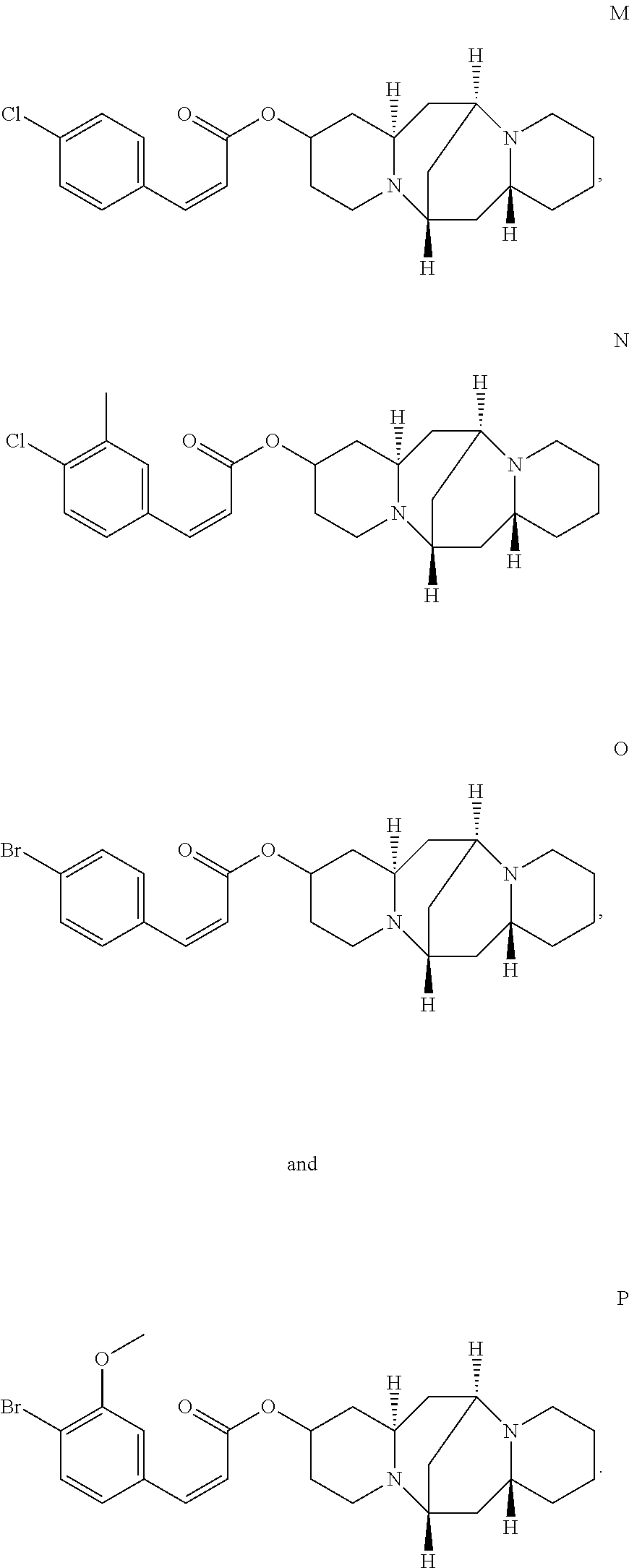
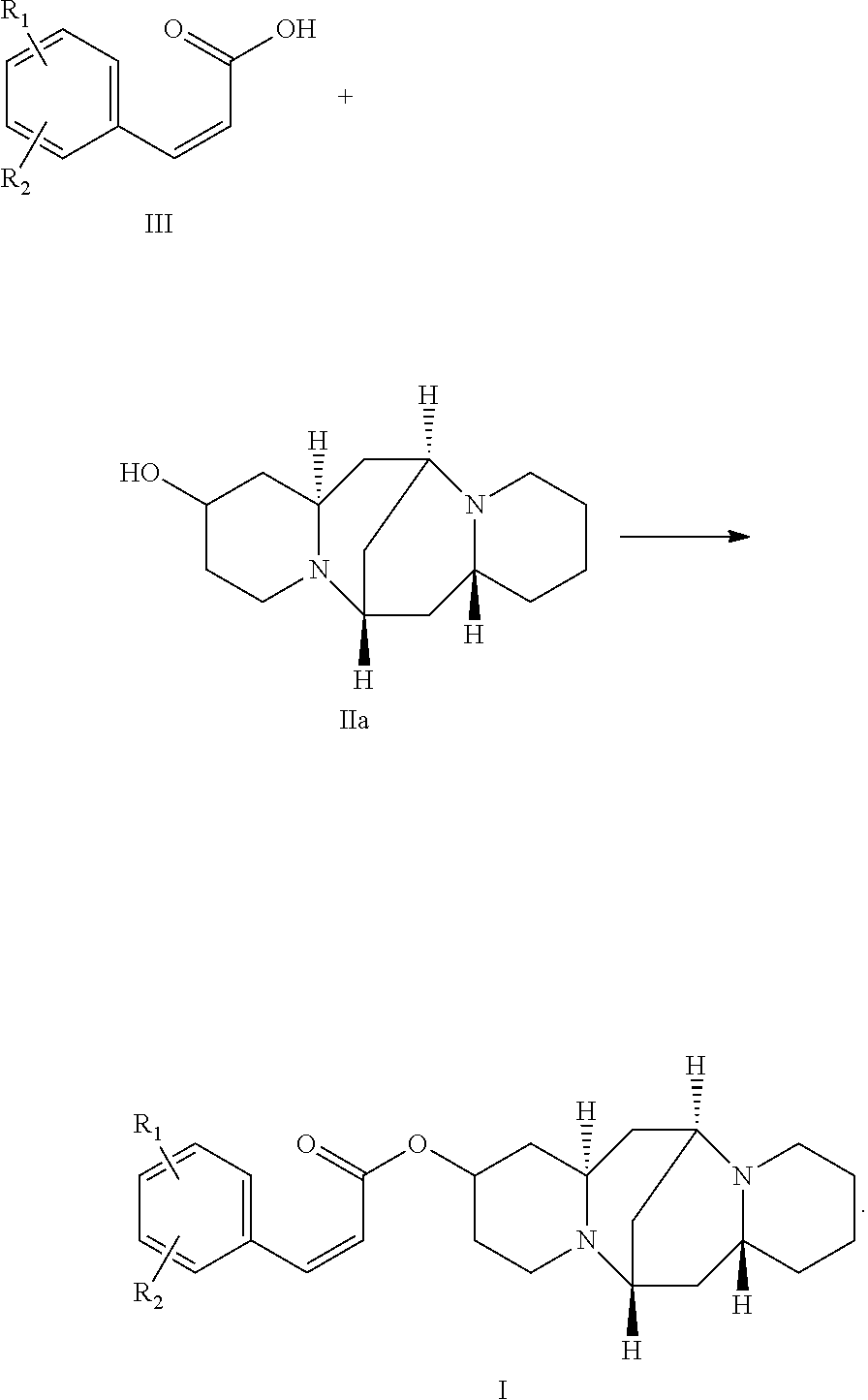




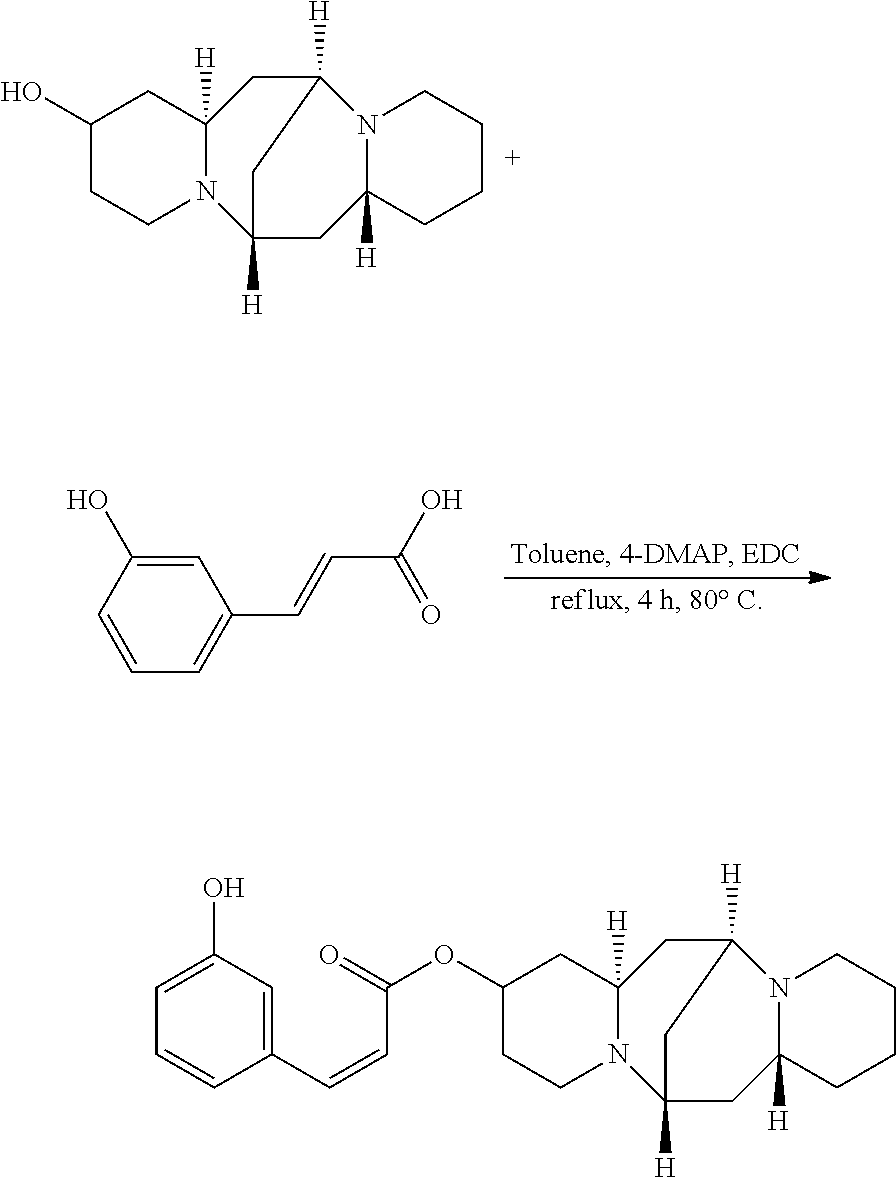
View All Diagrams
| United States Patent | 10,233,183 |
| Liang , et al. | March 19, 2019 |
13-hydroxysparteine cinnamic acid derivatives with anti-tumor activities and a method of preparing the same
Abstract
A compound having the following formula I: ##STR00001## In formula I, R.sub.1 and R.sub.2 are independently H, alkyl, alkoxy, and halogen. A method of preparing the compound of formula I is also disclosed.
| Inventors: | Liang; Chengyuan (Xi'an, CN), Tian; Lei (Xi'an, CN), Tang; Yonghong (Xi'an, CN), Chang; Minghui (Xi'an, CN), Shi; Kaiqi (Xi'an, CN), Ju; Xingke (Xi'an, CN), Liu; Yuzhi (Xi'an, CN), Wen; Lili (Xi'an, CN), Li; Han (Xi'an, CN), Wang; Xuechuan (Xi'an, CN) | ||||||||||
|---|---|---|---|---|---|---|---|---|---|---|---|
| Applicant: |
|
||||||||||
| Assignee: | SHAANXI UNIVERSITY OF SCIENCE AND
TECHNOLOGY (Xi'an, CN) |
||||||||||
| Family ID: | 64196362 | ||||||||||
| Appl. No.: | 16/043,085 | ||||||||||
| Filed: | July 23, 2018 |
Foreign Application Priority Data
| Jul 18, 2018 [CN] | 2018 1 0793138 | |||
| Current U.S. Class: | 1/1 |
| Current CPC Class: | C07D 471/22 (20130101); A61P 35/00 (20180101) |
| Current International Class: | C07D 471/22 (20060101) |
| Field of Search: | ;546/63 |
Other References
|
Claramunt, R.M. et al.: Conformational analysis of heterocyclic analogues of tetrahydrodibenzocyclooctene: tetrahydrobisbenzimidazoldiazocine and tetrahydrobis pyridodiazocinediium dibromide. Tetrahedron, vol. 54, pp. 9569-9580, 1998. cited by examiner. |
Primary Examiner: Aulakh; Charanjit
Attorney, Agent or Firm: SZDC Law P.C.
Claims
What is claimed is:
1. A compound having the following formula I: ##STR00026## wherein R.sub.1 and R.sub.2 are independently selected from the group consisting of H, hydroxyl, alkyl, alkoxy, and halogen.
2. The compound of claim 1, wherein the compound is selected from the group consisting of: ##STR00027## ##STR00028## ##STR00029##
3. A method of preparing the compound of claim 1 comprising: reacting a compound of formula III with a compound of formula IIa: ##STR00030##
4. The method of claim 3, wherein the compound of formula III is selected from the group consisting of: ##STR00031## ##STR00032##
5. The method of claim 3, wherein the compound of formula IIa and the compound of formula III react in a molar ratio of 1:1 to 1:1.3, in an organic solvent, in the presence of a catalyst and a condensate, and at 60-100.degree. C. for 4-12 hours.
6. The method of claim 5, wherein the organic solvent is toluene, DMF, or acetonitrile.
7. The method of claim 6, wherein the organic solvent is toluene.
8. The method of claim 5, wherein the condensate is DCC, EDC, or HOBT.
9. The method of claim 8, wherein the condensate is DCC.
10. The method of claim 5, wherein the catalyst is 4-DMAP or triethylamine.
11. The method of claim 5, wherein the molar ratio of the compound of formula IIa and the compound of formula III is 1:1.3.
Description
The present invention claims priority to Chinese Patent Application No. 201810793138.X, filed on Jul. 18, 2018, which is incorporated by reference for all purposes as if fully set forth herein.
BACKGROUND OF THE INVENTION
Field of the Invention
The present invention relates to the field of pharmaceutical chemistry, and more particularly, to sparteine cinnamic acid derivatives with anti-tumor activities and a method of preparing these derivatives.
Discussion of the Related Art
Tumor is a serious threat to human health. The mechanism of action of anti-tumor drugs and the targets of drugs are different. The development of multidrug resistance in tumor cells often leads to treatment failure. There are needs to develop new safe and effective anti-tumor drugs with few toxic side effects.
Finding safe, effective, and toxic side effects has always been the goal of cancer drug development workers. With the development of medicinal chemistry, the role of compounds with a cinnamic acid structure as a mother core in anti-tumor therapy has attracted widespread attention.
Sparteine (formula II) has a wide range of biological activities, such as anti-arrhythmia, anti-microbial infection, anti-ulcer, and elevated white blood cells. The source of sparteine is widely distributed, and it can be extracted from plants. 13-Hydroxysparteine (formula IIa) is a naturally-occurring sparteine derivative which is isolated from gorse, and it has a structure in which a hydroxy group is added to the 13 position of sparteine.
##STR00002##
Cinnamic acid and its partial derivatives are widely distributed in many natural products, such as propolis, vegetables and fruits, and are natural antioxidants. In recent years, studies have shown that cinnamic acid compounds and their derivatives have a wide range of biological activities, such as antioxidant, tyrosinase inhibition, anti-tumor, affecting plant growth and enhancing immunity, in medicine, pesticides, plastics, photosensitive resins, foods. They have a wide range of uses such as additives and flavors and fragrances. The cinnamic acid compounds are natural antioxidants and have strong ability to scavenge free radical DPPH. Studies have shown that the cancerous stage is involved in oxygen free radicals, so cinnamic acid compounds may have some anti-tumor activities.
In the present application, 13-hydroxysparteine is linked with cinnamic acid and its derivatives by an ester bond via a condensation reaction, resulting novel 13-hydroxysparteine cinnamate derivatives. These derivatives have anti-tumor activities and thus important medical application value.
It is an object of the present invention to provide a 13-hydroxysparteine cinnamate derivative having antitumor activity and a method of preparing the same.
SUMMARY OF THE INVENTION
In one embodiment, the present invention provides a compound (a 13-hydroxysparteine cinnamate derivative) having the following formula I:
##STR00003##
In formula I, R1 and R2 are independently selected from the group consisting of H, hydroxyl, alkyl, alkoxy, and halogen.
In another embodiment, the compound is selected from the group consisting of:
##STR00004## ##STR00005## ##STR00006##
In one embodiment, the present invention provides a method of preparing the compound. The method includes: reacting a compound of formula III with a compound of formula IIa:
##STR00007##
In another embodiment, the compound of formula III is selected from the group consisting of:
##STR00008## ##STR00009##
In another embodiment, the compound of formula IIa and the compound of formula III react in a molar ratio of 1:1 to 1:1.3, in an organic solvent, in the presence of a catalyst and a condensate, and at 60-100.degree. C. for 4-12 hours.
In another embodiment, the organic solvent is toluene, DMF (dimethylformamide), or acetonitrile.
In another embodiment, the organic solvent is toluene.
In another embodiment, the condensate is DCC (N,N'-dicyclohexylcarbodiimide), EDC (1-ethyl-3-(3-dimethylaminopropyl)carbodiimide), or HOBT (hydroxybenzotriazole).
In another embodiment, the condensate is DCC.
In another embodiment, the catalyst is 4-DMAP (4-dimethylaminopyridine) or triethylamine.
In another embodiment, the molar ratio of the compound of formula IIa and the compound of formula III is 1:1.3.
It is to be understood that both the foregoing general description and the following detailed description are exemplary and explanatory and are intended to provide further explanation of the invention as claimed.
BRIEF DESCRIPTION OF THE DRAWINGS
The accompanying drawings, which are included to provide a further understanding of the invention and are incorporated in and constitute a part of this specification, illustrate embodiments of the invention and together with the description serve to explain the principles of the invention.
In the drawings:
FIG. 1 shows the .sup.1H-NMR spectrum of Compound A.
FIG. 2 shows the .sup.13C-NMR spectrum of Compound A.
DETAILED DESCRIPTION OF THE ILLUSTRATED EMBODIMENTS
Reference will now be made in detail to embodiments of the present invention. These examples are for illustrative purposes only and do not limit the scope or spirit of the invention.
Example 1
Preparation of (Z)-(6S,7aR,13S,14aR)-tetradecahydro-6,13-methanodipyrido[1,2-a:1',2'-e][- 1,5]diazocin-2-yl 3-phenylacrylate (Compound A)
A mixture of 25.02 mg (0.10 mmol) 13-hydroxysparteine and 19.25 mg (0.13 mmol) cinnamic acid were dissolved in 50 mL toluene in a reactor. 2.46 mg (0.02 mmol) 4-DMAP and 2.06 mg (0.01 mmol) DCC were added to the mixture, and the mixture was heated at 80.degree. C. for 8 hours. The solvent (toluene) in the mixture was removed under reduced pressure. Ethyl acetate was added to the mixture, and mixture was washed with water, sodium bicarbonate solution, and sodium chloride solution. The solvent (ethyl acetate) in the mixture was removed under reduced pressure. The mixture was then cooled down and filtered to give 29.00 mg compound A as a crystalline compound, a yield of 76.26%.
##STR00010##
.sup.1H-NMR (400 MHz, DMSO-d.sub.6) .delta. (ppm): 7.60 (2H, d), 7.32-7.40 (4H, m), 6.59 (1H, d), 3.92 (1H, s), 2.72-3.17 (4H, m), 2.64-2.72 (4H, m), 1.76-1.93 (4H, m), 1.48-1.69 (4H, m), 1.45-1.48 (6H, m), 1.18-1.32 (2H, m); .sup.13C-NMR (75 MHz, DMSO-d6) .delta. (ppm): 169.0, 139.7, 135.4, 129.0, 128.7, 127.5, 124.5, 65.3, 62.0, 60.8, 56.3, 55.4, 47.9, 39.5, 38.8, 32.1, 28.6, 26.4, 25.0, 23.8; MS (ESI) for (M+H).sup.+: 381.3.
The .sup.1H-NMR spectrum of Compound A is shown in FIG. 1, and the .sup.13C-NMR spectrum of Compound A is shown in FIG. 2.
Example 2
Preparation of (Z)-(6S,7aR,13S,14aR)-tetradecahydro-6,13-methanodipyrido[1,2-a:1',2'-e][- 1,5]diazocin-2-yl 3-(4-hydroxyphenyl)acrylate (Compound B)
A mixture of 25.02 mg (0.10 mmol) 13-hydroxysparteine and 16.40 mg (0.10 mmol) 4-hydroxycinnamic acid were dissolved in 50 mL acetonitrile in a reactor. 2.46 mg (0.02 mmol) 4-DMAP and 2.06 mg (0.01 mmol) DCC were added to the mixture, and the mixture was heated at 80.degree. C. for 12 hours. The solvent (acetonitrile) in the mixture was removed under reduced pressure. Ethyl acetate was added to the mixture, and mixture was washed with water, sodium bicarbonate solution, and sodium chloride solution. The solvent (ethyl acetate) in the mixture was removed under reduced pressure. The mixture was then cooled down and filtered to give 27.94 mg compound B as a crystalline compound, a yield of 70.52%.
##STR00011##
.sup.1H-NMR (400 MHz, DMSO-d.sub.6) .delta. (ppm): 7.48 (2H, d), 7.37 (1H, d), 6.56 (2H, d), 5.90 (1H, d), 5.28 (1H, s), 5.19 (1H, m), 2.58 (1H, m), 2.32-2.46 (4H, t), 2.13 (3H, m), 1.60-1.80 (4H, m), 1.35-1.52 (6H, t), 1.27-1.51 (6H, m); .sup.13C-NMR (75 MHz, DMSO-d.sub.6) .delta. (ppm): 167.2, 158.7, 146.3, 131.2, 128.7, 117.3, 116.2, 68.7, 65.4, 62.8, 59.0, 53.4, 47.4, 37.9, 37.2, 35.4, 32.4, 30.4, 27.3, 24.2; MS (ESI) for (M+Na).sup.+: 419.2.
Example 3
Preparation of (Z)-(6S,7aR,13S,14aR)-tetradecahydro-6,13-methanodipyrido[1,2-a:1',2'-e][- 1,5]diazocin-2-yl 3-(3-hydroxyphenyl)acrylate (Compound C)
A mixture of 25.02 mg (0.10 mmol) 13-hydroxysparteine and 16.40 mg (0.10 mmol) 3-hydroxycinnamic acid were dissolved in 50 mL toluene in a reactor. 2.46 mg (0.02 mmol) 4-DMAP and 2.06 mg (0.01 mmol) DCC were added to the mixture, and the mixture was heated at 80.degree. C. for 4 hours. The solvent (toluene) in the mixture was removed under reduced pressure. Ethyl acetate was added to the mixture, and mixture was washed with water, sodium bicarbonate solution, and sodium chloride solution. The solvent (ethyl acetate) in the mixture was removed under reduced pressure. The mixture was then cooled down and filtered to give 27.13 mg compound C as a crystalline compound, a yield of 68.48%.
##STR00012##
.sup.1H-NMR (400 MHz, DMSO-d.sub.6) .delta. (ppm): 7.48 (1H, t), 7.40 (1H, d), 7.09 (1H, d), 6.75 (1H, d), 6.62 (1H, s), 5.87 (1H, d), 5.16 (1H, s), 5.13 (1H, m), 2.56 (1H, m), 2.32-2.47 (4H, t), 2.13 (3H, m), 1.59-1.82 (4H, m), 1.34-1.51 (6H, t), 1.26-1.50 (6H, m); .sup.13C-NMR (75 MHz, DMSO-d.sub.6) .delta. (ppm): 167.5, 158.4, 145.9, 131.6, 128.3, 117.0, 116.2, 68.7, 65.4, 62.9, 59.2, 53.4, 47.2, 37.9, 37.2, 35.3, 32.4, 29.9, 27.2, 24.0; MS (ESI) for (M+H).sup.+: 397.3.
Example 4
Preparation of (Z)-(6S,7aR,13S,14aR)-tetradecahydro-6,13-methanodipyrido[1,2-a:1',2'-e][- 1,5]diazocin-2-yl 3-(3-hydroxyphenyl)acrylate (Compound D)
A mixture of 25.02 mg (0.10 mmol) 13-hydroxysparteine and 21.32 mg (0.13 mmol) 2-hydroxycinnamic acid were dissolved in 50 mL DMF in a reactor. 2.02 mg (0.02 mmol) triethylamine and 1.35 mg (0.01 mmol) HOBT were added to the mixture, and the mixture was heated at 80.degree. C. for 8 hours. The solvent (DMF) in the mixture was removed under reduced pressure. Ethyl acetate was added to the mixture, and mixture was washed with water, sodium bicarbonate solution, and sodium chloride solution. The solvent (ethyl acetate) in the mixture was removed under reduced pressure. The mixture was then cooled down and filtered to give 24.32 mg compound D as a crystalline compound, a yield of 63.95%.
##STR00013##
.sup.1H-NMR (400 MHz, DMSO-d.sub.6) .delta. (ppm): 7.61 (1H, d), 7.59 (1H, d), 7.01 (1H, t), 6.82 (1H, t), 6.56 (1H, d), 6.02 (1H, d), 5.19 (1H, s), 5.09 (1H, m), 2.60 (1H, m), 2.46-2.34 (4H, t), 2.15 (3H, m), 1.76-1.80 (2H, q), 1.51-1.59 (2H, t), 1.50-1.57 (6H, t), 1.27-1.36 (6H, m); .sup.13C-NMR (75 MHz, DMSO-d.sub.6) .delta. (ppm): 167.9, 158.3, 139.8, 130.4, 129.5, 123.1, 122.0, 118.9, 117.3, 68.4, 65.6, 63.0, 59.4, 53.0, 47.1, 38.0, 37.3, 35.4, 32.6, 30.4, 27.0, 24.3; MS (ESI) for (M+Na).sup.+: 419.2.
Example 5
Preparation of (Z)-(6S,7aR,13S,14aR)-tetradecahydro-6,13-methanodipyrido[1,2-a:1',2'-e][- 1,5]diazocin-2-yl 3-(3,4-dihydroxyphenyl)acrylate (Compound E)
A mixture of 25.02 mg (0.10 mmol) 13-hydroxysparteine and 23.40 mg (0.10 mmol) 3,4-dihydroxycinnamic acid were dissolved in 50 mL DMF in a reactor. 2.46 mg (0.02 mmol) 4-DMAP and 2.06 mg (0.01 mmol) DCC were added to the mixture, and the mixture was heated at 60.degree. C. for 8 hours. The solvent (DMF) in the mixture was removed under reduced pressure. Ethyl acetate was added to the mixture, and mixture was washed with water, sodium bicarbonate solution, and sodium chloride solution. The solvent (ethyl acetate) in the mixture was removed under reduced pressure. The mixture was then cooled down and filtered to give 26.97 mg compound E as a crystalline compound, a yield of 70.93%.
##STR00014##
.sup.1H-NMR (400 MHz, DMSO-d.sub.6) .delta. (ppm): 7.38 (1H, d), 7.12 (1H, s), 7.06 (1H, d), 6.85 (1H, d), 5.89 (1H, d), 5.27 (2H, d), 5.09 (1H, m), 2.60 (1H, m), 2.32-2.45 (4H, t), 2.24 (3H, m), 1.58-1.73 (4H, m), 1.51-1.58 (6H, t), 1.38-1.45 (2H, q), 1.29-1.37 (4H, m); .sup.13C-NMR (75 MHz, DMSO-d.sub.6) .delta. (ppm): 9168.2, 147.7, 147.1, 146.0, 128.6, 124.0, 118.4, 117.1, 116.0, 68.4, 65.6, 63.4, 59.2, 52.9, 47.2, 38.0, 37.3, 35.2, 32.6, 30.3, 27.0, 23.9; MS (ESI) for (M+H).sup.+: 413.2.
Example 6
Preparation of (Z)-(6S,7aR,13S,14aR)-tetradecahydro-6,13-methanodipyrido[1,2-a:1',2'-e][- 1,5]diazocin-2-yl 3-(4-hydroxy-3-methoxyphenyl)acrylate (Compound F)
A mixture of 25.02 mg (0.10 mmol) 13-hydroxysparteine and 25.22 mg (0.13 mmol) 4-hydroxy-3-methoxycinnamic acid were dissolved in 50 mL toluene in a reactor. 2.02 mg (0.02 mmol) triethylamine and 2.06 mg (0.01 mmol) DCC were added to the mixture, and the mixture was heated at 80.degree. C. for 12 hours. The solvent (toluene) in the mixture was removed under reduced pressure. Ethyl acetate was added to the mixture, and mixture was washed with water, sodium bicarbonate solution, and sodium chloride solution. The solvent (ethyl acetate) in the mixture was removed under reduced pressure. The mixture was then cooled down and filtered to give 23.02 mg compound F as a crystalline compound, a yield of 60.55%.
##STR00015##
.sup.1H-NMR (400 MHz, DMSO-d.sub.6) .delta. (ppm): 7.31 (1H, d), 7.03 (1H, s), 7.01 (1H, d), 6.90 (1H, d), 5.85 (1H, d), 5.23 (1H, d), 5.13 (1H, m), 3.73 (1H, s), 2.55 (1H, m), 2.40-2.33 (4H, t), 2.20 (3H, m), 1.49-1.77 (4H, m), 1.43-1.56 (6H, t), 1.30-1.42 (6H, m); .sup.13C-NMR (75 MHz, DMSO-d.sub.6) .delta. (ppm): 167.2, 150.3, 149.3, 146.3, 128.6, 124.2, 117.9, 117.3, 113.5, 68.2, 65.3, 63.4, 59.1, 52.9, 47.6, 37.8, 37.3, 35.2, 32.8, 30.3, 27.0, 23.9; MS (ESI) for (M+Na).sup.+: 449.2.
Example 7
Preparation of (Z)-(6S,7aR,13S,14aR)-tetradecahydro-6,13-methanodipyrido[1,2-a:1',2'-e][- 1,5]diazocin-2-yl 3-(4-hydroxy-3,5-dimethoxyphenyl)acrylate (Compound G)
A mixture of 25.02 mg (0.10 mmol) 13-hydroxysparteine and 22.41 mg (0.10 mmol) 4-hydroxy-3,5-dimethoxycinnamic acid were dissolved in 50 mL acetonitrile in a reactor. 2.46 mg (0.02 mmol) 4-DMAP and 2.06 mg (0.01 mmol) DCC were added to the mixture, and the mixture was heated at 100.degree. C. for 8 hours. The solvent (acetonitrile) in the mixture was removed under reduced pressure. Ethyl acetate was added to the mixture, and mixture was washed with water, sodium bicarbonate solution, and sodium chloride solution. The solvent (ethyl acetate) in the mixture was removed under reduced pressure. The mixture was then cooled down and filtered to give 31.53 mg compound B as a crystalline compound, a yield of 69.11%.
##STR00016##
.sup.1H-NMR (400 MHz, DMSO-d.sub.6) .delta. (ppm): 7.43 (1H, d), 6.70 (2H, s), 5.92 (1H, d), 5.29 (1H, s), 5.17 (1H, m), 3.77 (6H, s), 2.58 (1H, m), 2.32-2.43 (4H, t), 2.18 (3H, m), 1.63-1.81 (4H, m), 1.51-1.61 (6H, t), 1.22-1.34 (6H, m); .sup.13C-NMR (75 MHz, DMSO-d.sub.6) .delta. (ppm): 167.5, 149.0, 146.1, 137.6, 127.7, 117.2, 108.2, 68.8, 65.4, 63.1, 59.4, 57.1, 53.4, 47.4, 38.2, 35.7, 33.0, 30.9, 27.5, 24.6; MS (ESI) for (M+H).sup.+: 457.3.
Example 8
Preparation of (Z)-(6S,7aR,13S,14aR)-tetradecahydro-6,13-methanodipyrido[1,2-a:1',2'-e][- 1,5]diazocin-2-yl 3-(p-tolyl)acrylate (Compound H)
A mixture of 25.02 mg (0.10 mmol) 13-hydroxysparteine and 21.08 mg (0.13 mmol) 4-methylcinnamic acid were dissolved in 50 mL toluene in a reactor. 2.46 mg (0.02 mmol) 4-DMAP and 1.35 mg (0.01 mmol) HOBT were added to the mixture, and the mixture was heated at 100.degree. C. for 4 hours. The solvent (toluene) in the mixture was removed under reduced pressure. Ethyl acetate was added to the mixture, and mixture was washed with water, sodium bicarbonate solution, and sodium chloride solution. The solvent (ethyl acetate) in the mixture was removed under reduced pressure. The mixture was then cooled down and filtered to give 24.24 mg compound H as a crystalline compound, a yield of 61.47%.
##STR00017##
.sup.1H-NMR (400 MHz, DMSO-d.sub.6) .delta. (ppm): 7.49 (2H, d), 7.39 (1H, d), 7.08 (2H, d), 5.86 (1H, d), 5.12 (1H, m), 2.53 (1H, m), 2.31-2.41 (4H, t), 2.24 (3H, s), 2.13 (3H, m), 1.55-1.77 (4H, m), 1.49-1.53 (6H, t), 1.24-1.38 (6H, m); .sup.13C-NMR (75 MHz, DMSO-d.sub.6) .delta. (ppm): 167.5, 146.1, 138.6, 133.2, 129.5, 117.2, 68.5, 64.7, 63.0, 59.6, 56.1, 52.9, 47.9, 38.5, 35.3, 33.1, 30.7, 27.2, 23.6, 22.1; MS (ESI) for (M+Na).sup.+: 417.3.
Example 9
Preparation of (Z)-(6S,7aR,13S,14aR)-tetradecahydro-6,13-methanodipyrido[1,2-a:1',2'-e][- 1,5]diazocin-2-yl 3-(4-hydroxy-3-methylphenyl)acrylate (Compound I)
A mixture of 25.02 mg (0.10 mmol) 13-hydroxysparteine and 23.15 mg (0.13 mmol) 4-hydroxy-3-methylcinnamic acid were dissolved in 50 mL toluene in a reactor. 2.02 mg (0.02 mmol) triethylamine and 1.92 mg (0.01 mmol) EDC were added to the mixture, and the mixture was heated at 60.degree. C. for 8 hours. The solvent (toluene) in the mixture was removed under reduced pressure. Ethyl acetate was added to the mixture, and mixture was washed with water, sodium bicarbonate solution, and sodium chloride solution. The solvent (ethyl acetate) in the mixture was removed under reduced pressure. The mixture was then cooled down and filtered to give 25.98 mg compound I as a crystalline compound, a yield of 63.33%.
##STR00018##
.sup.1H-NMR (400 MHz, DMSO-d.sub.6) .delta. (ppm): 7.51 (1H, d), 7.40 (1H, d), 7.23 (1H, d), 6.97 (1H, s), 6.01 (1H, d), 5.40 (1H, s), 5.28 (1H, m), 2.67 (1H, m), 2.42-2.51 (4H, t), 2.24 (3H, m), 2.14 (3H, s), 1.67-1.87 (4H, m), 1.52-1.60 (6H, t), 1.36-1.41 (6H, m); .sup.13C-NMR (75 MHz, DMSO-d.sub.6) .delta. (ppm): 167.0, 153.7, 146.0, 128.2, 125.3, 116.9, 116.3, 68.9, 65.9, 62.9, 59.1, 53.0, 47.3, 38.6, 37.6, 35.6, 33.0, 30.8, 27.4, 24.9, 19.7; MS (ESI) for (M+H).sup.+: 411.6.
Example 10
Preparation of (Z)-(6S,7aR,13S,14aR)-tetradecahydro-6,13-methanodipyrido[1,2-a:1',2'-e][- 1,5]diazocin-2-yl 3-(m-tolyl)acrylate (Compound J)
A mixture of 25.02 mg (0.10 mmol) 13-hydroxysparteine and 16.21 mg (0.10 mmol) 3-methylcinnamic acid were dissolved in 50 mL acetonitrile in a reactor. 2.46 mg (0.02 mmol) 4-DMAP and 2.06 mg (0.01 mmol) DCC were added to the mixture, and the mixture was heated at 60.degree. C. for 4 hours. The solvent (acetonitrile) in the mixture was removed under reduced pressure. Ethyl acetate was added to the mixture, and mixture was washed with water, sodium bicarbonate solution, and sodium chloride solution. The solvent (ethyl acetate) in the mixture was removed under reduced pressure. The mixture was then cooled down and filtered to give 25.52 mg compound J as a crystalline compound, a yield of 64.72%.
##STR00019##
.sup.1H-NMR (400 MHz, DMSO-d.sub.6) .delta. (ppm): 7.44 (1H, s), 7.36 (1H, d), 7.09 (1H, t), 7.06 (1H, d), 7.04 (1H, s), 5.91 (1H, s), 5.17 (1H, m), 2.58 (1H, m), 2.36-2.46 (4H, m), 2.29 (3H, s), 2.18 (3H, m), 1.60-1.78 (4H, m), 1.35-1.53 (6H, t), 1.29-1.33 (6H, m); .sup.13C-NMR (75 MHz, DMSO-d.sub.6) .delta. (ppm): 167.5, 146.1, 139.3, 136.1, 129.5, 129.2, 127.6, 126.5, 117.2, 68.8, 65.4, 63.2, 63.0, 59.4, 53.4, 47.4, 38.2, 37.8, 35.7, 33.0, 30.9, 27.5, 24.6, 22.7; MS (ESI) for (M+Na).sup.+: 417.3.
Example 11
Preparation of (Z)-(6S,7aR,13S,14aR)-tetradecahydro-6,13-methanodipyrido[1,2-a:1',2'-e][- 1,5]diazocin-2-yl 3-(o-tolyl)acrylate (Compound K)
A mixture of 25.02 mg (0.10 mmol) 13-hydroxysparteine and 21.07 mg (0.10 mmol) 2-methylcinnamic acid were dissolved in 50 mL toluene in a reactor. 2.46 mg (0.02 mmol) 4-DMAP and 2.06 mg (0.01 mmol) DCC were added to the mixture, and the mixture was heated at 100.degree. C. for 12 hours. The solvent (toluene) in the mixture was removed under reduced pressure. Ethyl acetate was added to the mixture, and mixture was washed with water, sodium bicarbonate solution, and sodium chloride solution. The solvent (ethyl acetate) in the mixture was removed under reduced pressure. The mixture was then cooled down and filtered to give 23.02 mg compound K as a crystalline compound, a yield of 65.61%.
##STR00020##
.sup.1H-NMR (400 MHz, DMSO-d.sub.6) .delta. (ppm): 7.66 (1H, s), 7.21 (1H, d), 7.16 (2H, t), 6.91 (1H, d), 6.02 (1H, d), 5.12 (1H, m), 2.53 (1H, m), 2.38-2.41 (4H, t), 2.30 (3H, s), 2.13 (3H, m), 1.55-1.77 (4H, m), 1.49-1.53 (6H, t), 1.24-1.47 (6H, m); .sup.13C-NMR (75 MHz, DMSO-d.sub.6) .delta. (ppm): 168.0, 143.8, 137.7, 137.6, 129.3, 128.9, 127.8, 127.1, 117.7, 69.3, 65.9, 63.7, 63.5, 59.9, 53.9, 47.9, 38.7, 38.3, 36.2, 33.5, 31.4, 28.0, 25.1, 20.7; MS (ESI) for (M+H).sup.+: 395.3.
Example 12
Preparation of (Z)-(6S,7aR,13S,14aR)-tetradecahydro-6,13-methanodipyrido[1,2-a:1',2'-e][- 1,5]diazocin-2-yl 3-(2,4-dimethylphenyl)acrylate (Compound L)
A mixture of 25.02 mg (0.10 mmol) 13-hydroxysparteine and 17.61 mg (0.10 mmol) 2,4-dimethylcinnamic acid were dissolved in 50 mL toluene in a reactor. 2.46 mg (0.02 mmol) 4-DMAP and 2.06 mg (0.01 mmol) DCC were added to the mixture, and the mixture was heated at 80.degree. C. for 4 hours. The solvent (toluene) in the mixture was removed under reduced pressure. Ethyl acetate was added to the mixture, and mixture was washed with water, sodium bicarbonate solution, and sodium chloride solution. The solvent (ethyl acetate) in the mixture was removed under reduced pressure. The mixture was then cooled down and filtered to give 24.43 mg compound L as a crystalline compound, a yield of 59.83%.
##STR00021##
.sup.1H-NMR (400 MHz, DMSO-d.sub.6) .delta. (ppm): 7.61 (1H, d), 7.32 (1H, d), 6.90 (1H, s), 6.84 (1H, d), 5.97 (1H, d), 5.07 (1H, m), 2.58 (1H, m), 2.27-2.36 (4H, t), 2.33 (3H, s), 2.19 (3H, m), 2.08 (3H, m), 1.50-1.72 (4H, m), 1.44-1.48 (6H, t), 1.20-1.25 (6H, m); .sup.13C-NMR (75 MHz, DMSO-d.sub.6) .delta. (ppm): 168.5, 144.3, 135.8, 135.2, 132.8, 131.8, 127.9, 118.2, 69.8, 66.4, 64.2, 64.0, 54.4, 48.4, 39.2, 38.8, 36.7, 34.0, 31.9, 28.8, 25.6, 23.6, 21.5; MS (ESI) for (M+Na).sup.+: 431.3.
Example 13
Preparation of (Z)-(6S,7aR,13S,14aR)-tetradecahydro-6,13-methanodipyrido[1,2-a:1',2'-e][- 1,5]diazocin-2-yl 3-(4-chlorophenyl)acrylate (Compound M)
A mixture of 25.02 mg (0.10 mmol) 13-hydroxysparteine and 23.66 mg (0.13 mmol) 4-chlorocinnamic acid were dissolved in 50 mL DMF in a reactor. 2.46 mg (0.02 mmol) 4-DMAP and 1.92 mg (0.01 mmol) EDC were added to the mixture, and the mixture was heated at 80.degree. C. for 8 hours. The solvent (DMF) in the mixture was removed under reduced pressure. Ethyl acetate was added to the mixture, and mixture was washed with water, sodium bicarbonate solution, and sodium chloride solution. The solvent (ethyl acetate) in the mixture was removed under reduced pressure. The mixture was then cooled down and filtered to give 23.98 mg compound M as a crystalline compound, a yield of 57.90%.
##STR00022##
.sup.1H-NMR (400 MHz, DMSO-.sub.d6) .delta. (ppm): 7.68 (2H, d), 7.49 (1H, s), 7.44 (2H, d), 5.96 (1H, d), 5.22 (1H, m), 2.58 (1H, m), 2.40-2.51 (4H, t), 2.33 (3H, m), 1.65-1.87 (4H, m), 1.42-1.58 (6H, t), 1.34-1.40 (6H, m); .sup.13C-NMR (75 MHz, DMSO-d.sub.6) .delta. (ppm): 166.5, 144.1, 133.0, 128.2, 127.7, 114.9, 67.8, 63.4, 62.2, 62.0, 56.7, 52.0, 46.1, 35.3, 34.7, 31.4, 29.9, 25.1, 23.1; MS (ESI) for (M+H).sup.+: 415.2.
Example 14
Preparation of (Z)-(6S,7aR,13S,14aR)-tetradecahydro-6,13-methanodipyrido[1,2-a:1',2'-e][- 1,5]diazocin-2-yl 3-(4-chloro-3-methylphenyl)acrylate (Compound N)
A mixture of 25.02 mg (0.10 mmol) 13-hydroxysparteine and 17.61 mg (0.13 mmol) 4-chloro-3-methylcinnamic acid were dissolved in 50 mL DMF in a reactor. 2.46 mg (0.02 mmol) 4-DMAP and 1.35 mg (0.01 mmol) HOBT were added to the mixture, and the mixture was heated at 80.degree. C. for 8 hours. The solvent (DMF) in the mixture was removed under reduced pressure. Ethyl acetate was added to the mixture, and mixture was washed with water, sodium bicarbonate solution, and sodium chloride solution. The solvent (ethyl acetate) in the mixture was removed under reduced pressure. The mixture was then cooled down and filtered to give 26.15 mg compound N as a crystalline compound, a yield of 61.07%.
##STR00023##
.sup.1H-NMR (400 MHz, DMSO-d.sub.6) .delta. (ppm): 7.49 (2H, d), 7.49 (1H, s), 7.21 (1H, d), 6.95 (1H, s) 5.91 (1H, d), 5.17 (1H, m), 2.46 (1H, m), 2.46-2.50 (4H, t), 2.36 (3H, d), 2.12 (3H, m), 1.60-1.83 (4H, m), 1.43-1.55 (6H, t), 1.31-1.42 (6H, m); .sup.13C-NMR (75 MHz, DMSO-d.sub.6) .delta. (ppm): 165.9, 145.1, 133.8, 132.1, 128.2, 126.9, 125.4, 115.4, 66.9, 64.3, 62.0, 61.3, 58.1, 51.7, 45.8, 36.0, 34.4, 32.0, 29.7, 24.1, 23.5, 20.3; MS (ESI) for (M+Na).sup.+: 451.2.
Example 15
Preparation of (Z)-(6S,7aR,13S,14aR)-tetradecahydro-6,13-methanodipyrido[1,2-a:1',2'-e][- 1,5]diazocin-2-yl 3-(4-bromophenyl)acrylate (Compound O)
A mixture of 25.02 mg (0.10 mmol) 13-hydroxysparteine and 29.38 mg (0.13 mmol) 4-bromocinnamic acid were dissolved in 50 mL acetonitrile in a reactor. 2.02 mg (0.02 mmol) triethylamine and 2.06 mg (0.01 mmol) DCC were added to the mixture, and the mixture was heated at 80.degree. C. for 8 hours. The solvent (acetonitrile) in the mixture was removed under reduced pressure. Ethyl acetate was added to the mixture, and mixture was washed with water, sodium bicarbonate solution, and sodium chloride solution. The solvent (ethyl acetate) in the mixture was removed under reduced pressure. The mixture was then cooled down and filtered to give 30.34 mg compound O as a crystalline compound, a yield of 66.22%.
##STR00024##
.sup.1H-NMR (400 MHz, DMSO-d.sub.6) .delta. (ppm): 7.68 (2H, d), 7.46 (2H, d), 7.40 (1H, d), 5.89 (1H, d), 5.21 (1H, m), 2.61 (1H, m), 2.40-2.54 (4H, t), 2.33 (3H, m), 1.59-1.81 (4H, m), 1.57-1.65 (6H, m), 1.31-1.48 (6H, m); .sup.13C-NMR (75 MHz, DMSO-d.sub.6) .delta. (ppm): 165.6, 145.1, 132.7, 127.5, 120.7, 115.1, 67.8, 63.4, 62.0, 61.3, 57.2, 52.3, 45.6, 37.2, 35.4, 34.1, 31.7, 28.8, 26.5, 23.2; MS (ESI) for (M+H).sup.+: 459.2.
Example 16
Preparation of (Z)-(6S,7aR,13S,14aR)-tetradecahydro-6,13-methanodipyrido[1,2-a:1',2'-e][- 1,5]diazocin-2-yl 3-(4-bromo-3-methoxyphenyl)acrylate (Compound P)
A mixture of 25.02 mg (0.10 mmol) 13-hydroxysparteine and 33.28 mg (0.13 mmol) 4-bromo-3-methoxycinnamic acid were dissolved in 50 mL acetonitrile in a reactor. 2.02 mg (0.02 mmol) triethylamine and 2.06 mg (0.01 mmol) DCC were added to the mixture, and the mixture was heated at 60.degree. C. for 12 hours. The solvent (acetonitrile) in the mixture was removed under reduced pressure. Ethyl acetate was added to the mixture, and mixture was washed with water, sodium bicarbonate solution, and sodium chloride solution. The solvent (ethyl acetate) in the mixture was removed under reduced pressure. The mixture was then cooled down and filtered to give 33.54 mg compound P as a crystalline compound, a yield of 68.70%.
##STR00025##
.sup.1H-NMR (400 MHz, DMSO-d.sub.6) .delta. (ppm): 7.39 (1H, s), 7.30 (1H, d), 7.09 (1H, d), 6.82 (1H, s), 5.88 (1H, d), 5.13 (1H, m), 3.81 (3H, s), 2.46 (1H, m), 2.28-2.49 (4H, m), 2.26 (3H, m), 1.61-1.77 (4H, m), 1.42-1.59 (6H, m), 1.27-1.40 (6H, m); .sup.13C-NMR (75 MHz, DMSO-d.sub.6) .delta. (ppm): 164.6, 155.3, 143.8, 133.7, 132.4, 119.2, 115.4, 112.5, 110.6, 67.0, 64.4, 62.1, 57.6, 54.7, 50.6, 45.9, 36.4, 33.3, 31.0, 28.4, 25.1, 22.4; MS (ESI) for (M+Na).sup.+: 511.16.
Example 17
The compounds of the present invention were subjected to tumor cell proliferation inhibition test, and conventional MTT method was used.
Cell lines used: non-small cell lung cancer cells (H1975), human hepatoma cells (HepG2), human glioma cells (U251), human gastric adenocarcinoma cells (AGS), human breast cancer cells (1590). The culture medium was DMEM+15% NBS+double antibody.
Sample solution preparation: after dissolving with DMSO (Merck), PBS (-) was added to obtain 100 .mu.mol/L solution or homogeneous suspension. The solution was diluted with PBS (-) in DMSO to a final concentration of 0.1, 1, 10, 20, 40, 60, 80, 100 .mu.mol/L.
Antitumor cytarabine (Ara-C) was used as control solution, prepared under the same condition.
Cell culture: adherent growth Tumor cells were cultured in 1640 medium containing 10% inactivated neonatal bovine serum and penicillin, streptomycin (1 million U/L), placed in carbon dioxide incubator at 37.degree. C., 5% CO.sub.2, and saturated humidity. Cells were treated serially passaged 2-3 times. The first culture was washed with PBS 2 times, and digested with trypsin. Fresh culture medium was added evenly, cells were adjusted to a appropriate concentration and transferred into a new culture flask. Cell in an exponential phase were chosen for the tests.
MTT Assay for Cell Viability and IC.sub.50 Determination:
Experimental Principle: Living cells mitochondria in the dehydrogenase can reduce yellow MTT to water-insoluble blue-violet product MT (MTT formazan), deposited in the cells. The amount of production is proportional to the number of living cells. Dead cells do not reduce yellow MTT. DMSO can dissolve blue violet crystals, and the color depth is proportional to the amount contained, so the absorbance measured by the microplate reader can reflect the cell viability.
Methods: The exponential phase cells were digested and counted and seeded in 96-well plates at a density of 2.times.104/mL at 100 .mu.l per well. After 24 hours of incubation, the cells to be tested were treated with 0.1, 1, 10, 20, 40, 60, 80, 100 .mu.mol/L of the compounds. Each experimental group had 5 wells in each concentration, and the culture medium containing 0.4% DMSO was used as control. After 48 hours, the supernatant was discarded, and 100 .mu.l of MTT ((2-(4,5-dimethyl-2-thiazolyl)-3,5-diphenyl-2H-tetrazole hydrobromide) (1 mg/mL) was added to each well. After another 4 hours, the supernatant was discarded, and 100 .mu.l of DMSO was added to each well. After mixing, the absorbance was measured at 570 nm using a microplate reader. An IC.sub.50 calculation software was used to determine the half inhibitory concentration (IC.sub.50).
The test results are shown in Table 1. The compounds listed in the table correspond to the compounds described above.
TABLE-US-00001 TABLE 1 Half Inhibitory Concentration of Compounds on Different Tumor Cells IC.sub.50 (unit: .mu.mol/L) IC.sub.50 (.mu.mol/L) Comp H1975 HepG2 U251 AGS 1590 A 16.89 .+-. 1.36 36.55 .+-. 3.01 >100 20.34 .+-. 1.12 32.01 .+-. 1.69 B >100 53.69 .+-. 0.34 74.98 .+-. 0.49 >100 >100 C 23.69 .+-. 2.37 73.55 .+-. 0.49 5.49 .+-. 1.98 26.34 .+-. 1.48 43.21 .+-. 0.95 D 9.48 .+-. 1.48 11.84 .+-. 2.48 63.14 .+-. 0.75 51.84 .+-. 0.31 33.67 .+-. 1.11 E 43.15 .+-. 1.24 >100 42.16 .+-. 0.88 >100 36.21 .+-. 1.98 F >100 >100 >100 >100 88.64 .+-. 2.12 G 55.48 .+-. 0.48 >100 36.98 .+-. 1.24 59.44 .+-. 0.97 >100 H 29.89 .+-. 1.59 51.14 .+-. 1.44 75.44 .+-. 0.897 35.67 .+-. 2.58 >100 I >100 58.66 .+-. 1.78 66.89 .+-. 1.84 32.59 .+-. 0.29 >100 J 64.98 .+-. 1.89 88.46 .+-. 1.26 74.62 .+-. 2.94 >100 65.43 .+-. 0.47 K 89.63 .+-. 1.34 >100 >100 69.81 .+-. .060 >100 M >100 26.84 .+-. 1.24 45.88 .+-. 1.82 55.54 .+-. .044 10.59 .+-. 1.33 Ara-C 19.17 .+-. 0.39 20.64 .+-. 0.54 39.16 .+-. 0.54 >100 76.31 .+-. 2.48
The results show that these compounds have good antitumor activities. Specifically, Compounds A, C, D, E, G, H, I and M show good in vitro antitumor activities in different cell lines. The above experimental results indicate that the compounds (sparteine cinnamic acid derivatives) of the present invention have good antitumor activities and can be used for the study of antitumor agents.
It will be apparent to those skilled in the art that various modifications and variations can be made in the present invention without departing from the spirit or scope of the invention. Thus, it is intended that the present invention cover the modifications and variations of this invention provided they come within the scope of the appended claims and their equivalents.
* * * * *
C00001

C00002

C00003

C00004

C00005

C00006

C00007

C00008

C00009

C00010

C00011

C00012

C00013
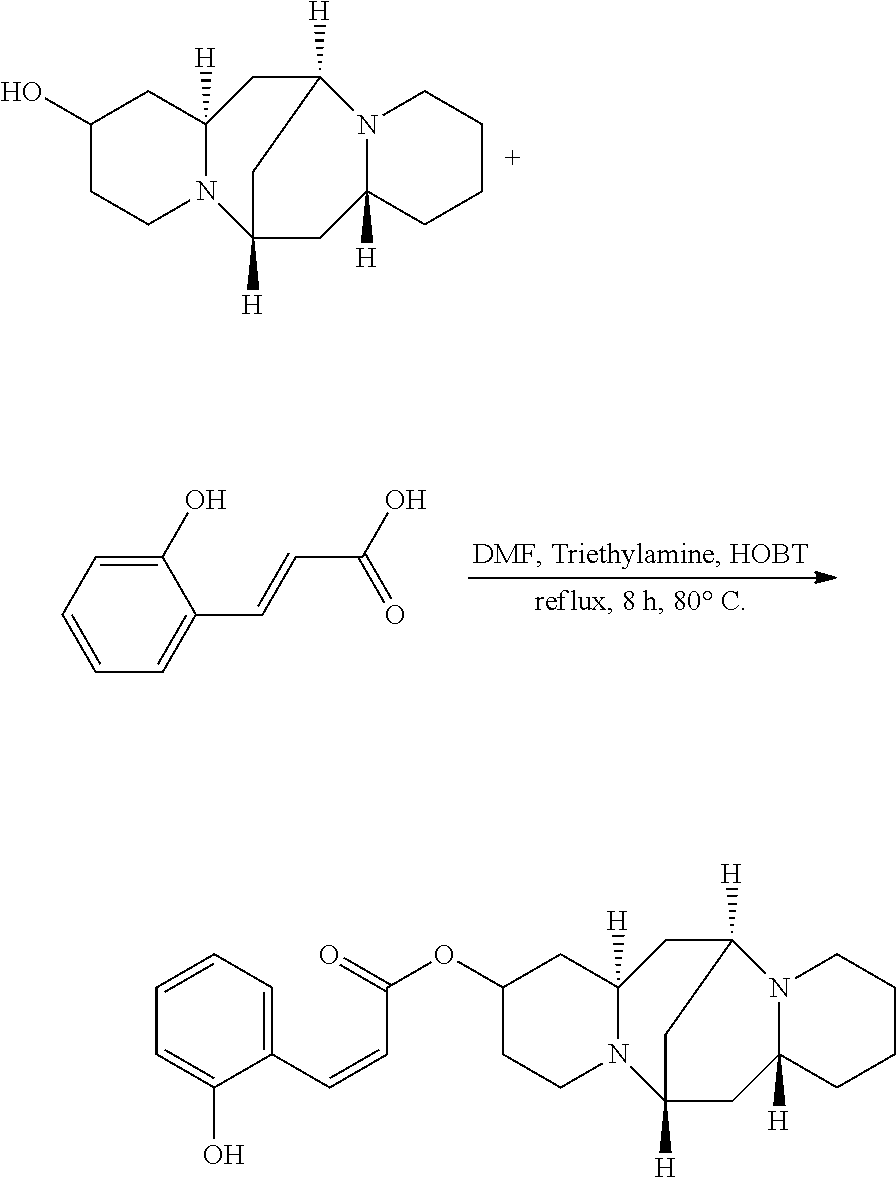
C00014
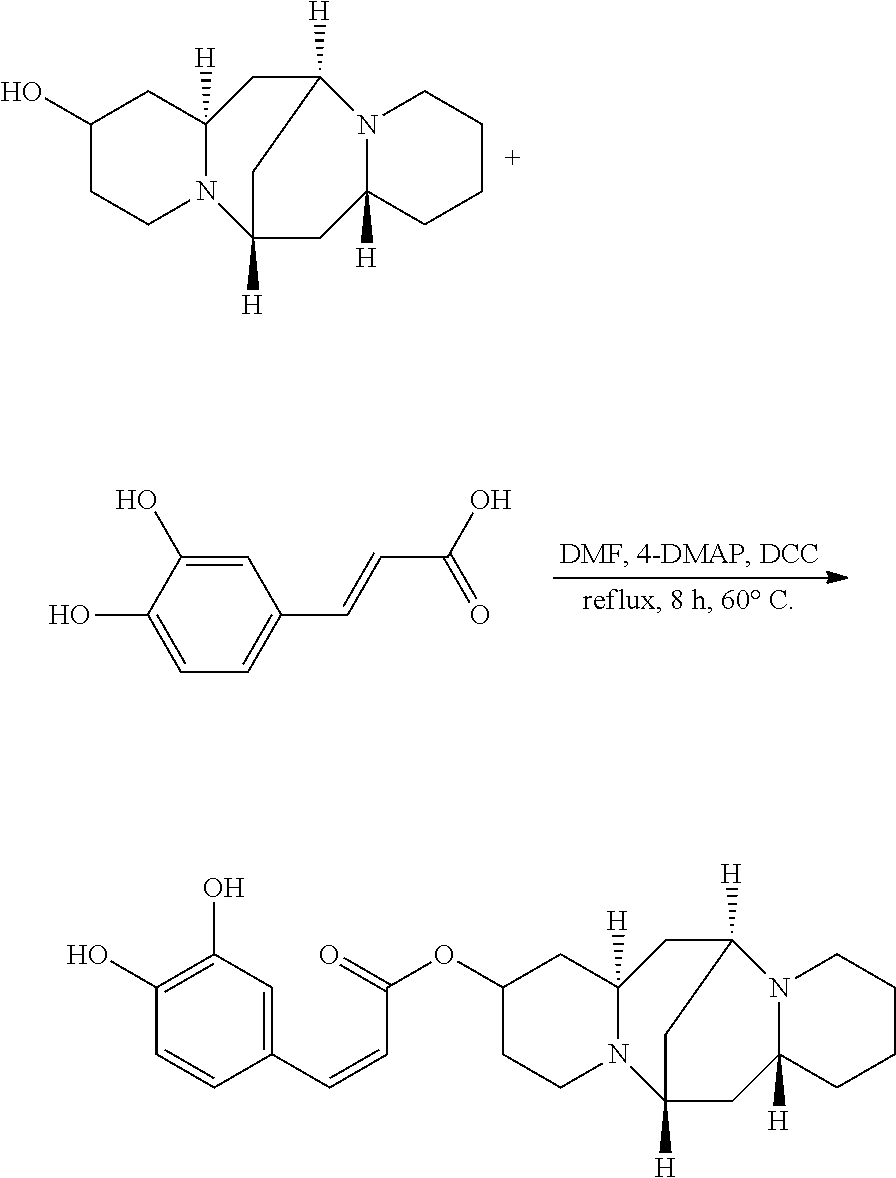
C00015
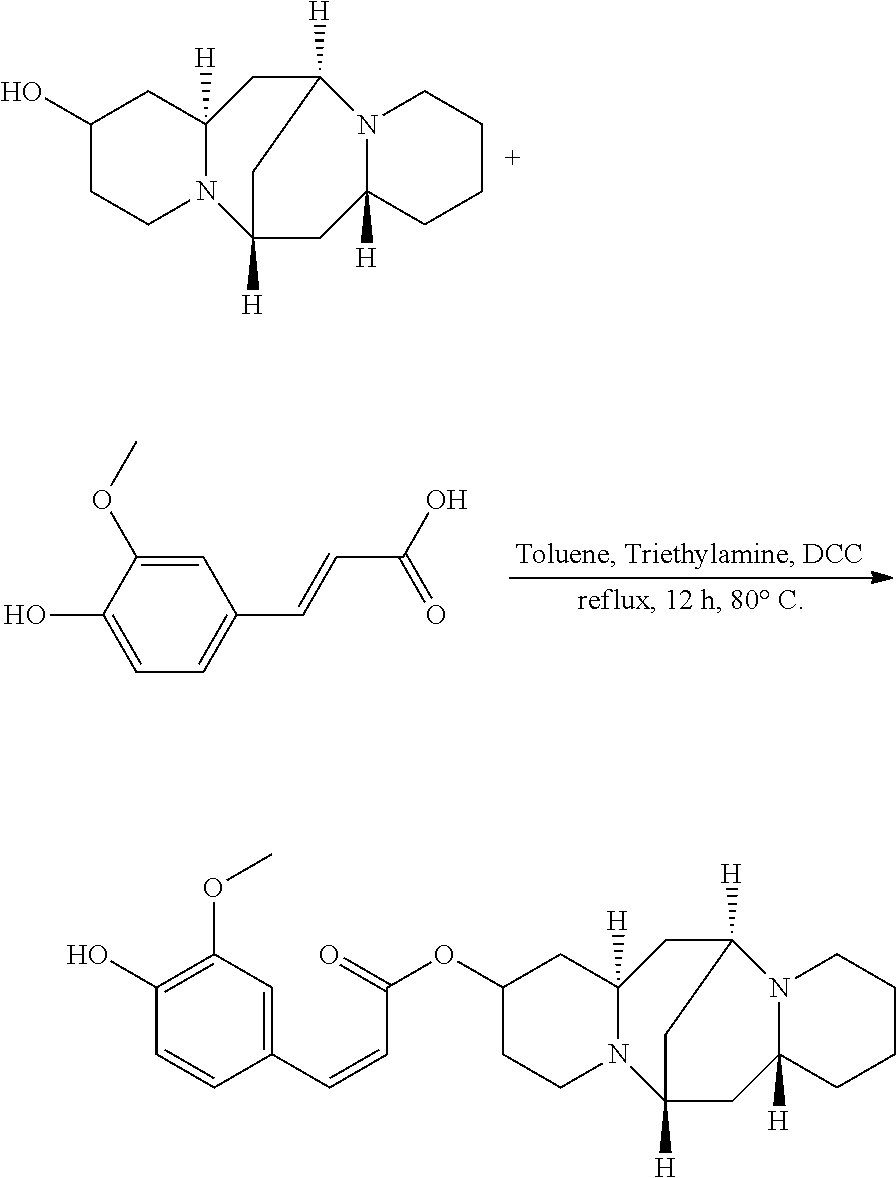
C00016
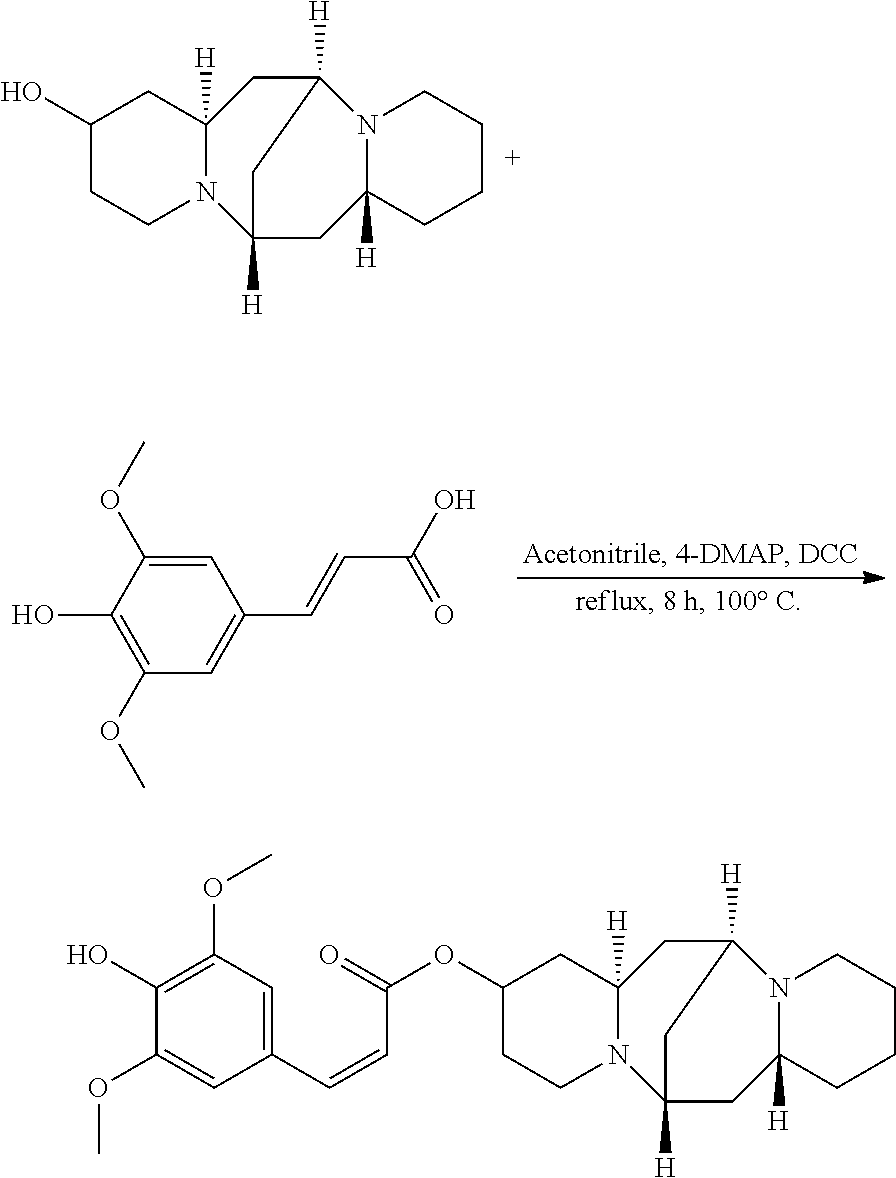
C00017

C00018
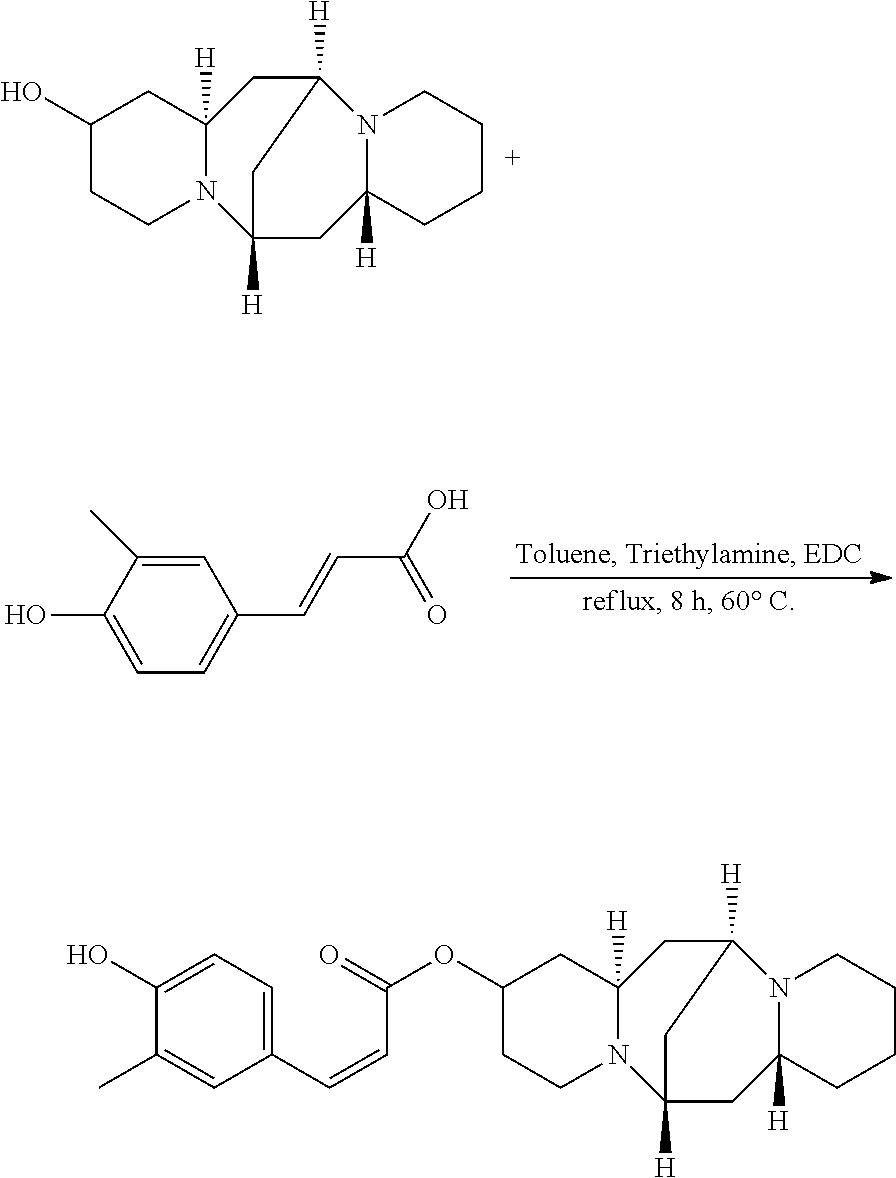
C00019

C00020

C00021
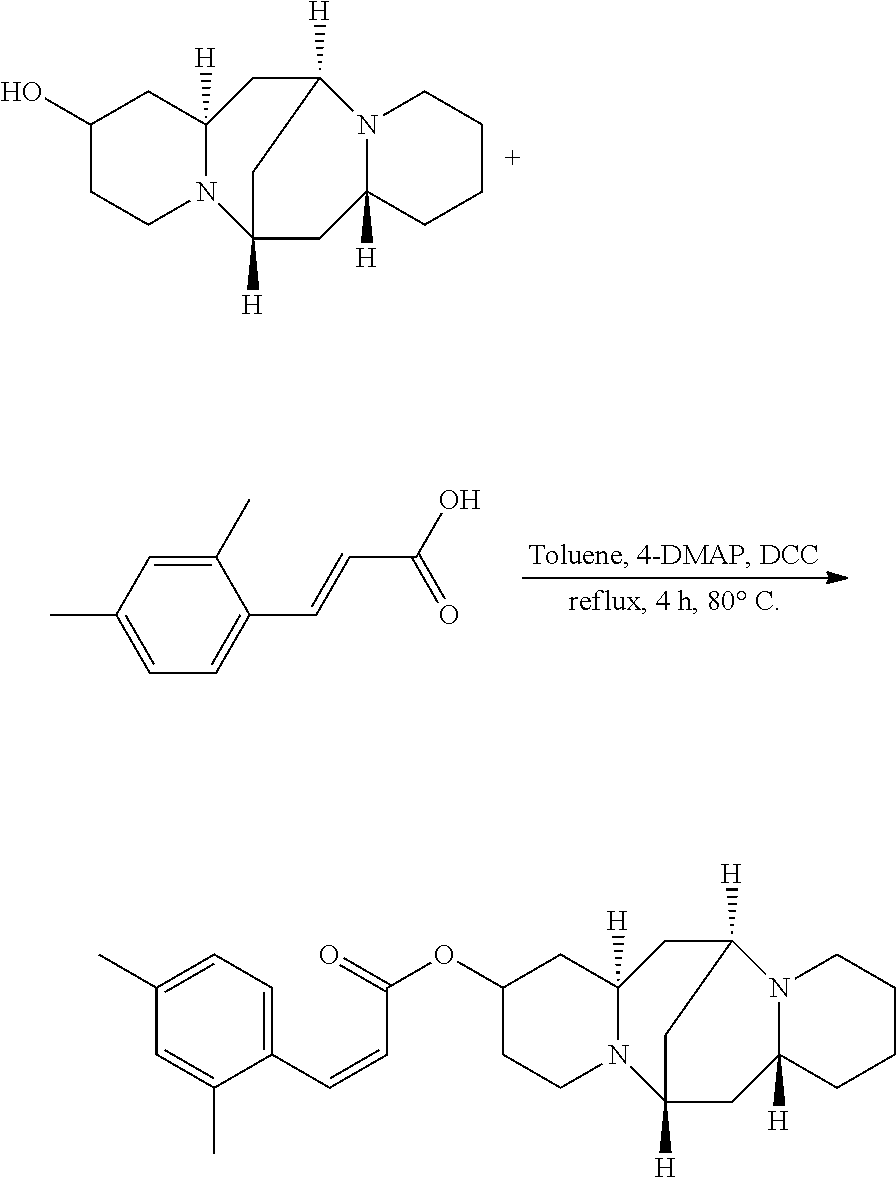
C00022
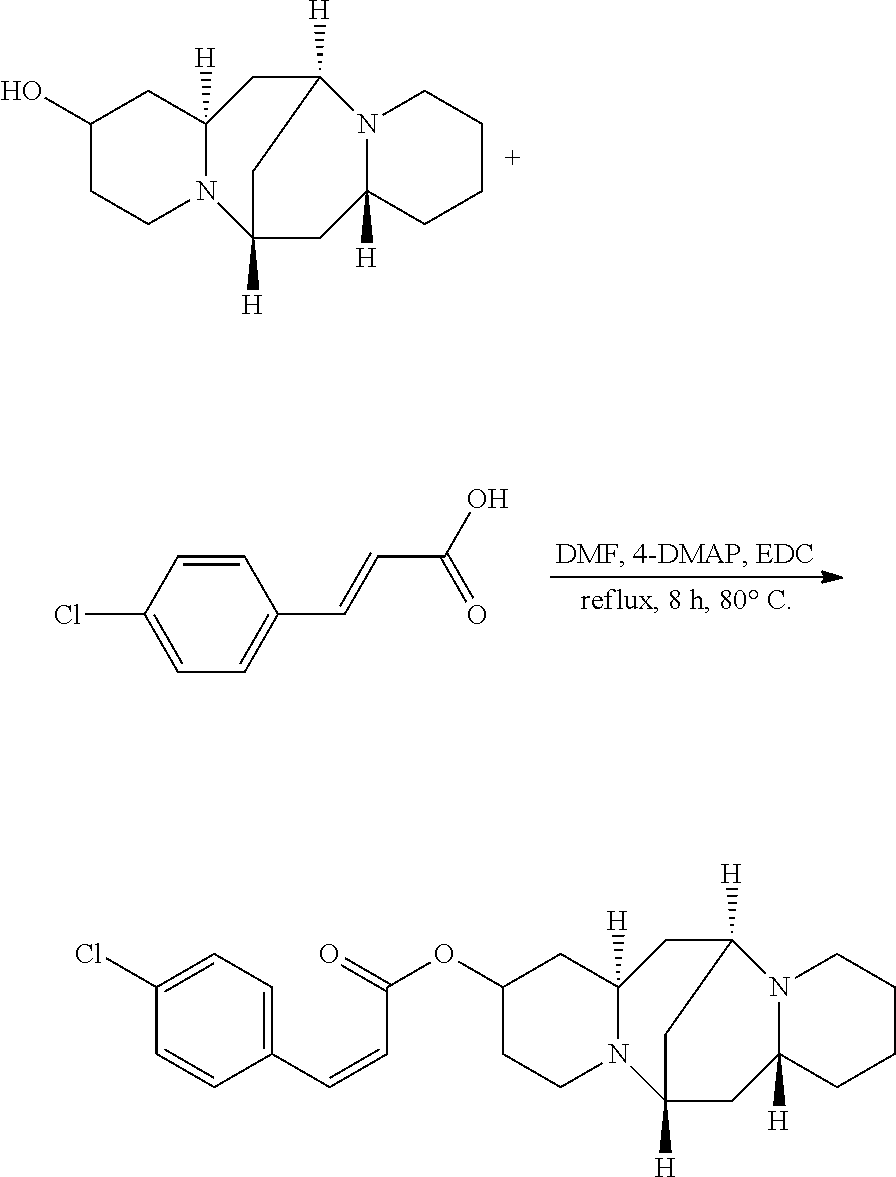
C00023

C00024
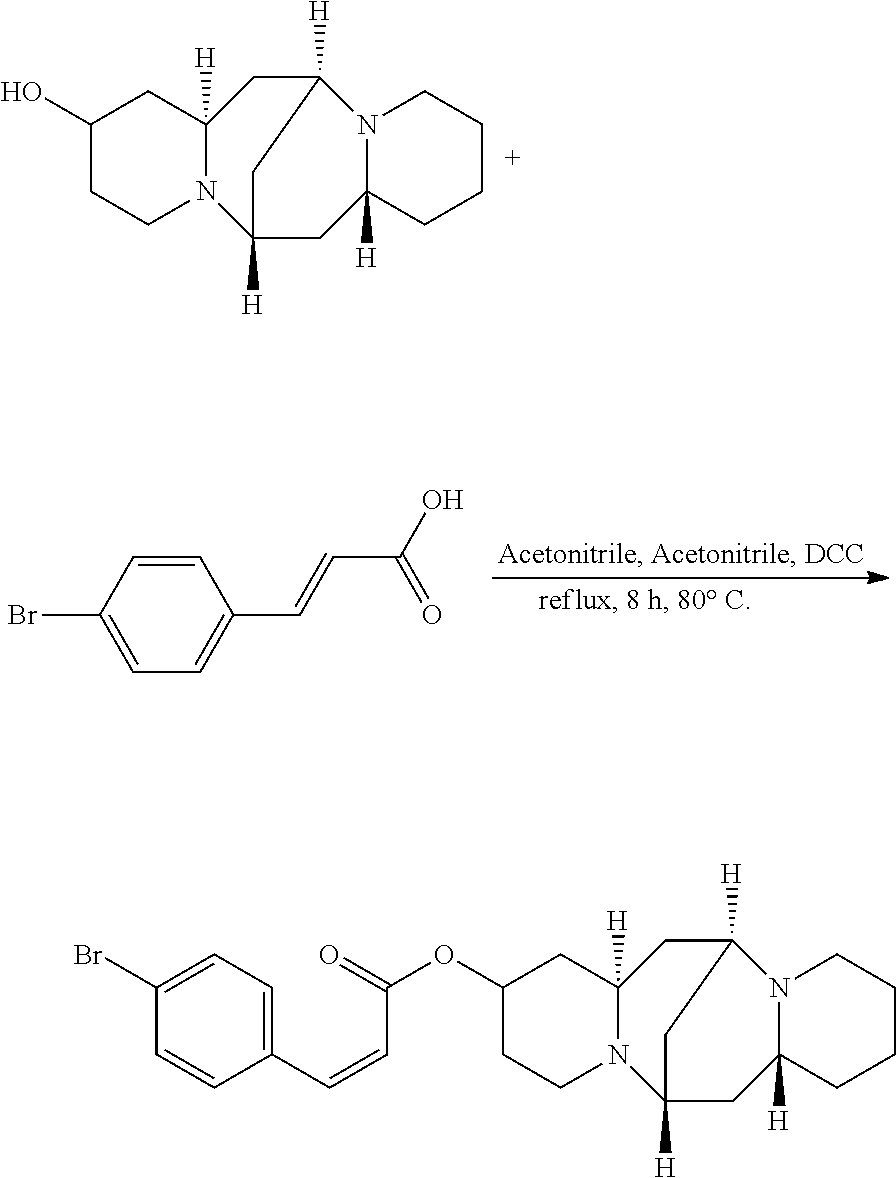
C00025

C00026
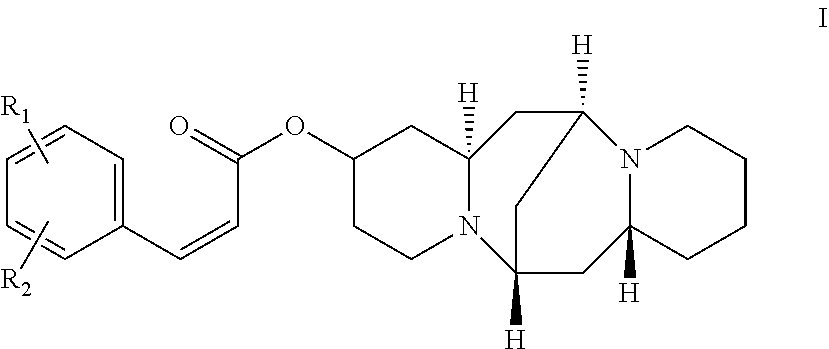
C00027

C00028

C00029
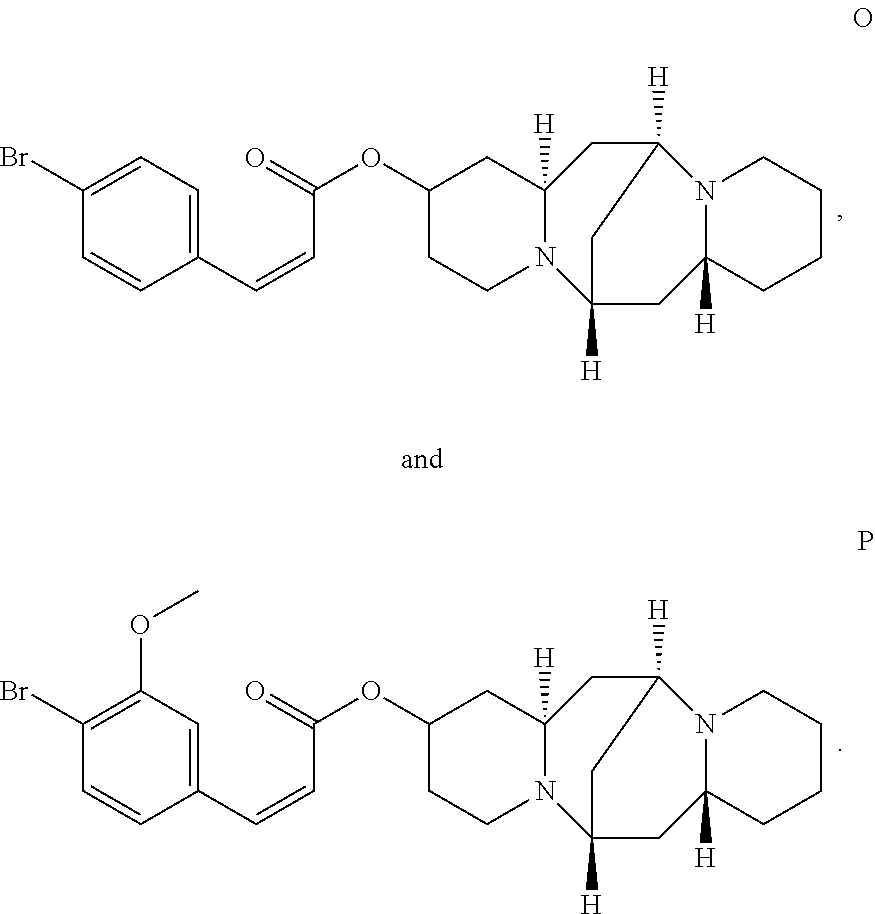
C00030
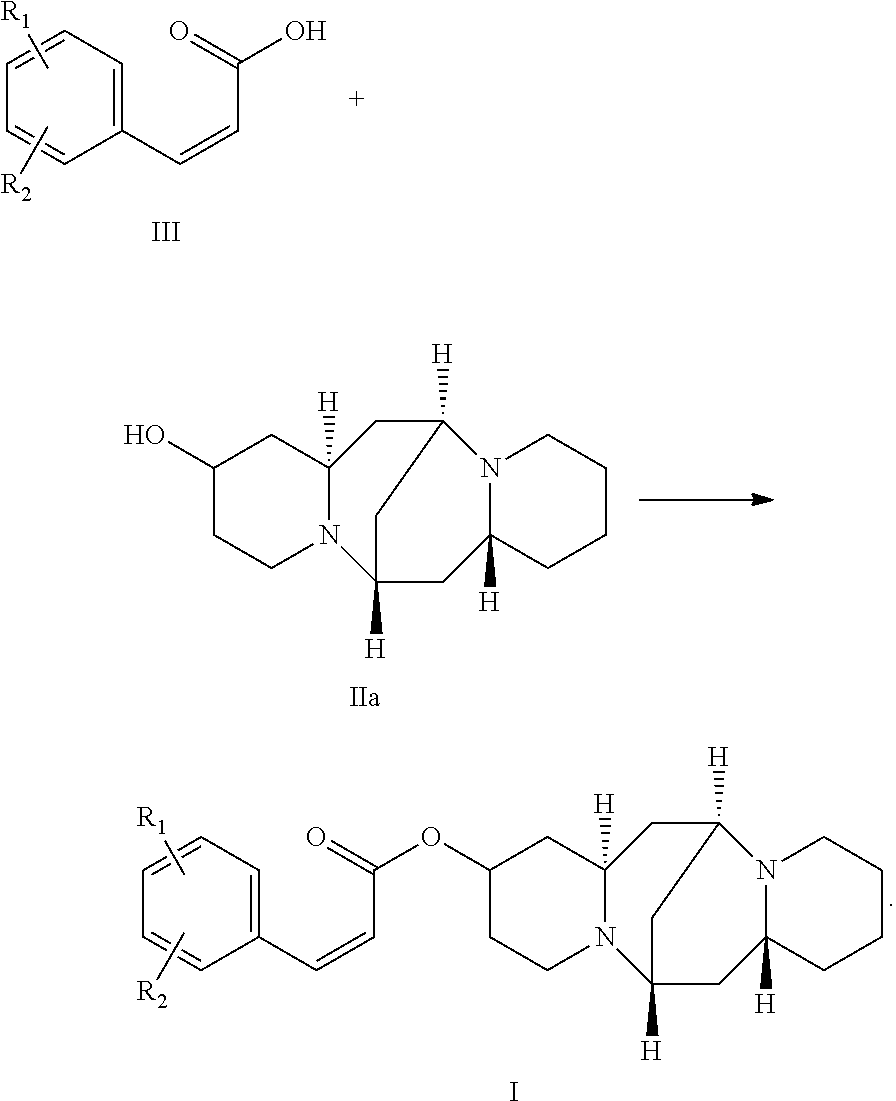
C00031

C00032
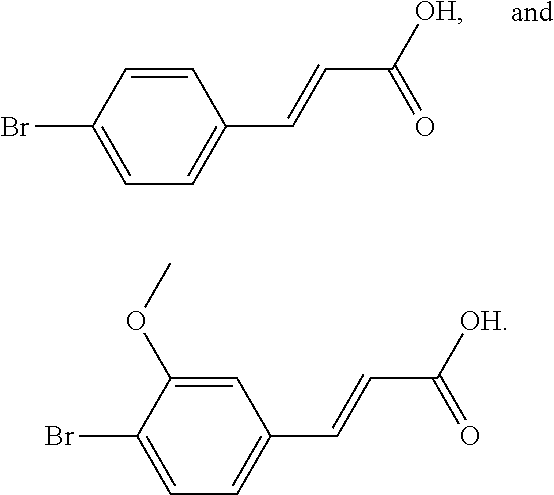
D00001
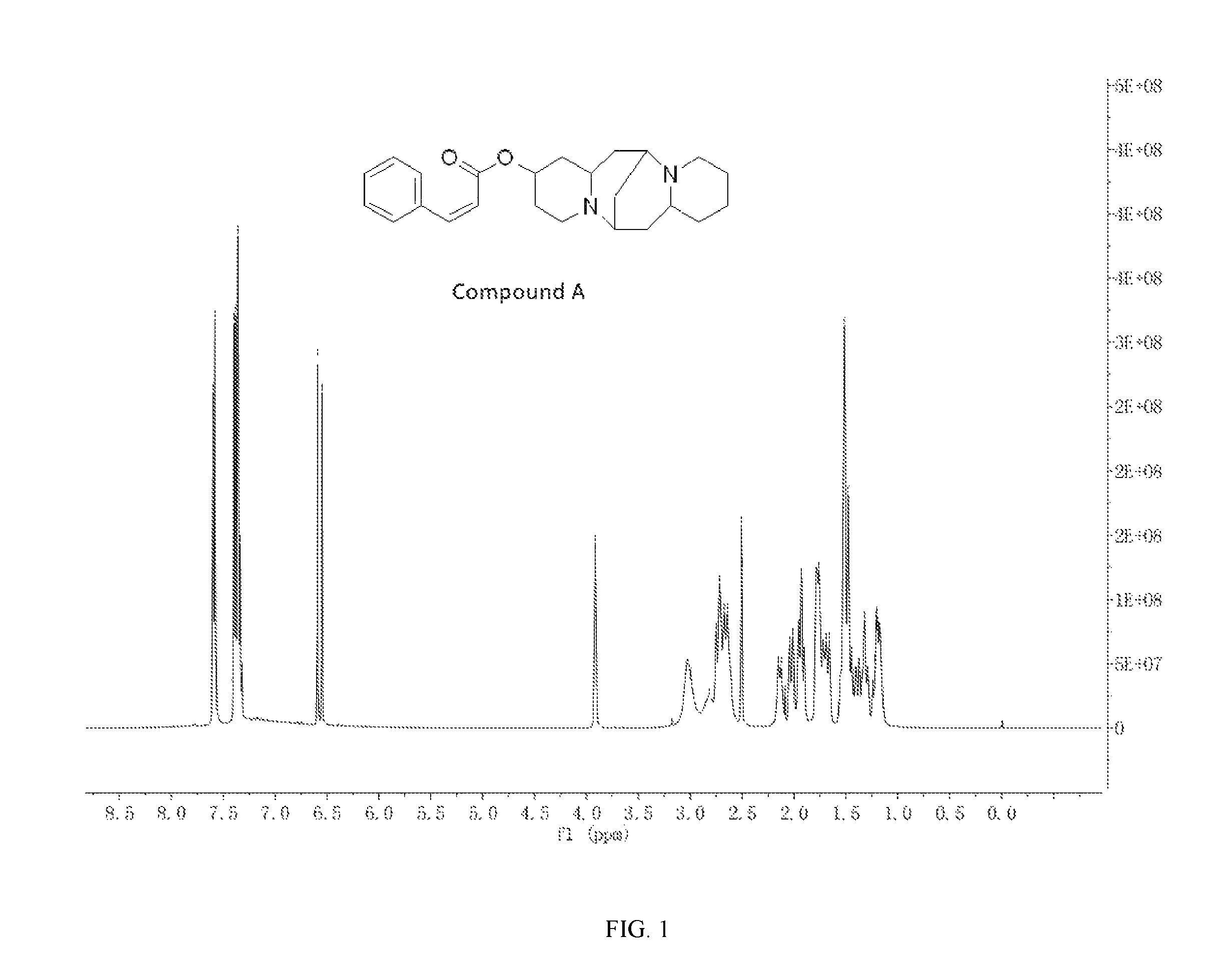
D00002
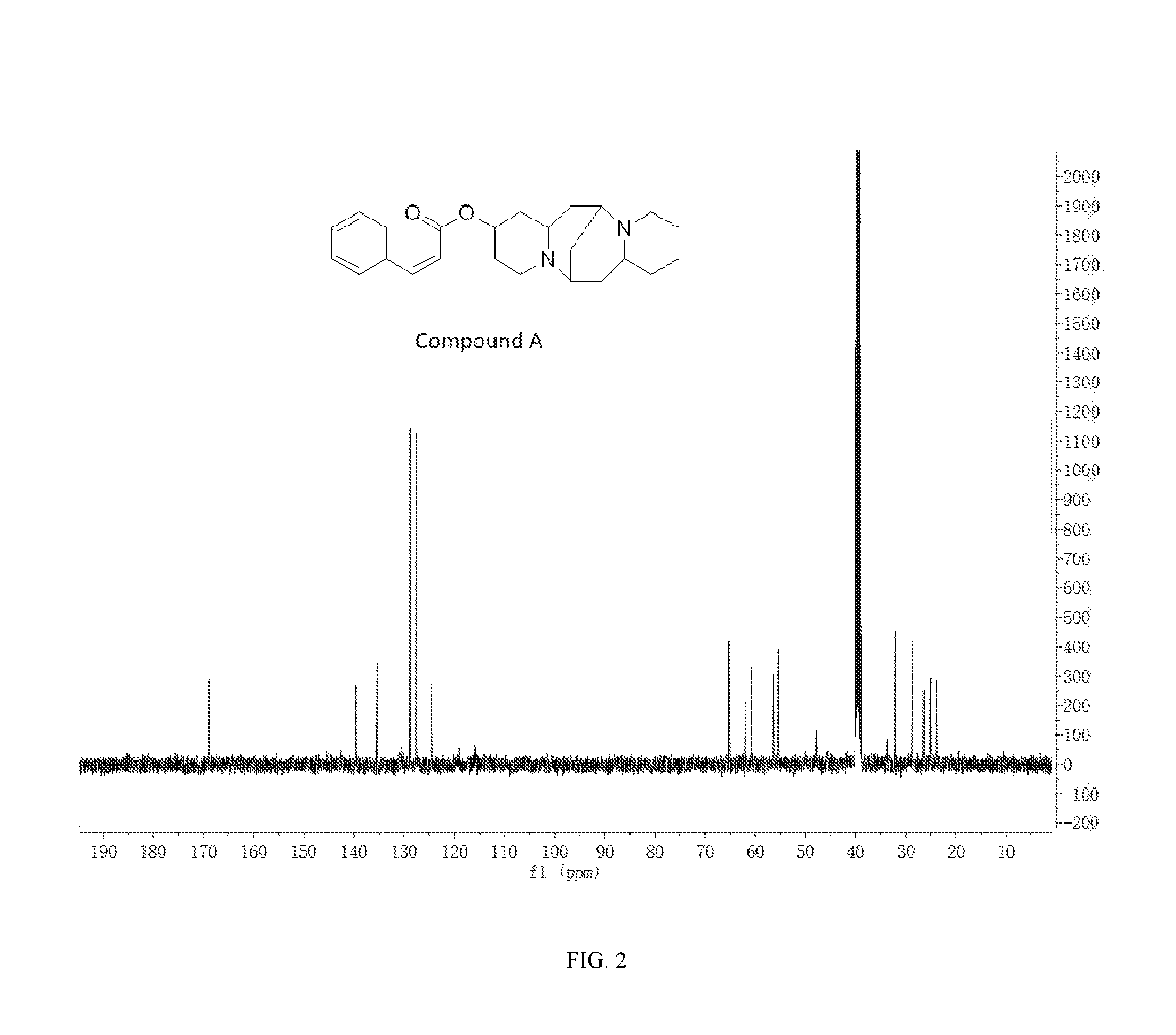
XML
uspto.report is an independent third-party trademark research tool that is not affiliated, endorsed, or sponsored by the United States Patent and Trademark Office (USPTO) or any other governmental organization. The information provided by uspto.report is based on publicly available data at the time of writing and is intended for informational purposes only.
While we strive to provide accurate and up-to-date information, we do not guarantee the accuracy, completeness, reliability, or suitability of the information displayed on this site. The use of this site is at your own risk. Any reliance you place on such information is therefore strictly at your own risk.
All official trademark data, including owner information, should be verified by visiting the official USPTO website at www.uspto.gov. This site is not intended to replace professional legal advice and should not be used as a substitute for consulting with a legal professional who is knowledgeable about trademark law.